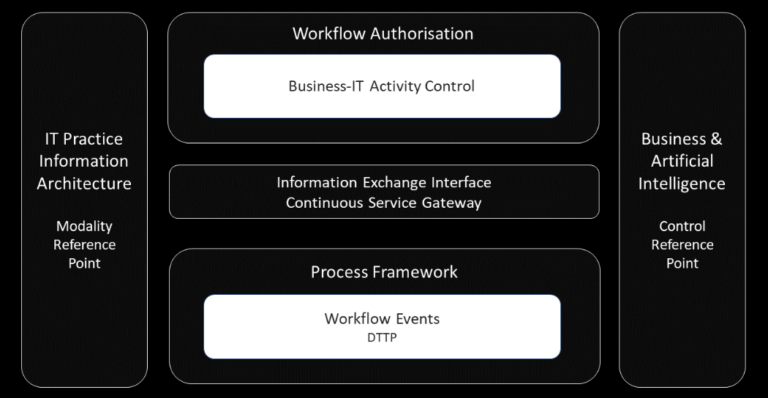Innovation Engineering Framework
“We’re not just transforming systems—we’re evolving digital practice to serve people, protect the planet and make progress purposeful.”
The Advanced Digital Transformation (ADT) framework delivers real-time insights for informed decision-making, agility and seamless collaboration. It enhances transparency, streamlines communication and supports proactive risk management to ensure strategic alignment and sustainable success.
By integrating cutting-edge technologies like the Internet of Events (IoE), machine learning and predictive analytics, ADT enables effectiveness, minimises waste and strengthens accountability. Essentially, ADT bridges the gap between Industry 4.0 and 5.0, ensuring digital transformation is not only technologically advanced but also ethical, sustainable and focussed on human well-being.
It represents the next stage in digital evolution, driving a purposeful, truly intelligent transition to the future. This vision empowers human creativity, enabling resilience and innovation in tackling complex social, economic and environmental challenges. The aim is to drive sustainable and high-value economic growth, one rooted in efficiency rather than inflated by waste.
Advanced Digital Transformation - Ingenuity


Inspire and motivate human ingenuity to thrive in the face of complex social, economic and environmental issues.
Advanced Digital Transformation - Evolution
Richard Feynman initially asserted, likely in his book “The Pleasure of Finding Things Out,” that IT emerged from the imperative need to perform complex calculations within the unforgiving timescale of the Manhattan Project. However, the term “Information Technology” was formally introduced in a 1958 Harvard Business Review article by authors H. J. Leavitt and T. C. Whisler, who stated, ‘The new technology does not yet have a single established name. We shall call it Information Technology.’
Drawing inspiration from the evolution of economic principles in 1933, where microeconomics and macroeconomics were introduced, a similar approach can be applied to Information Technology. Introducing micro IT and macro IT domains may offer a solution.
Micro-level IT focuses on the quality of how individual computers and their components create, process, store, retrieve and exchange various types of electronic data and information. This level of IT is driven by the instructions, data or programs that operate computers and execute specific tasks. It encompasses the detailed interactions between hardware, firmware and software, as well as communications at the computer level, ensuring efficient and accurate data management and processing.
Whereas, Macro-level IT, which is central to Advanced Digital Transformation, focuses on the overall quality of control necessary for successfully delivering improvement. This level of IT integrates processes for
- cultivating, evaluating, selecting and prioritising innovation and creative change
- transforming system requirements (or characteristics) into digital services aligned with goals, vision and values
- monitoring and ensuring the delivery of service performance against agreed standards, and
- reporting business intelligence related to project costs and benefits.

Advanced Digital Transformation - Challenge
The initiative is grounded in the essential need to harness innovation and creative change to ensure the future well-being of our economic and social landscape. The convergence of emerging technologies, population growth, geopolitical instability, climate change and challenges related to human and technological aging underscores the importance of proactive adaptation to meet future needs.
“It is imperative to develop a more effective, efficient and equitable approach to applying computer science to complex societal, environmental and economic issues. We must strive to overcome status quo bias and avoid high-risk, limited-capability alternatives.” — PS
The core challenge lies in the complexities of computer system development, which are further compounded by the absence of an integrated strategy to coordinate and navigate processes such as business innovation, digital transformation, service delivery and value management. This lack of integration leads to misunderstandings, assumptions and omissions, resulting in ambiguity, project failures and, in some cases, disasters.
The proposed modern, systematically integrated architecture for fostering innovation and creative change is based on principles of good governance. It includes: a comprehensive process framework for optimal effectiveness; an information architecture designed to enhance efficiency; a seamless data interface for managing operational dependencies; and a real-time activity dashboard to support improved decision-making. Learn more in the article: The Future of Digital Practice Management and The ADT Series #1 – 10 (LinkedIn Articles)
Advanced Digital Transformation - Solution
The progressive development of organisational design, in alignment with the evolving business and technology ecosystems, necessitates the implementation of efficient solutions characterised by transparency and fairness. A collaborative approach (encompassing streamlined public services, stakeholder capitalism and socially motivated investing, with an emphasis on prioritising purpose as a key driver of profit) can significantly contribute to the creation of functional markets, thriving societies and environmental protection. The seamless integration of information systems engineering processes with real-time intelligent technology is essential for achieving these outcomes effectively.

Within a process framework matrix, significant but routine events seamlessly trigger workflow activity via the Digital Transformation Transfer Protocol (DTTP) – a critical set of embedded rules that interprets event data, manages workflows and delivers actionable behaviour analytics.
These activities undergo validation and authorisation by key subsystems (Demand Control, Transform Control, Service Control and Value Control) each of which manages the operational dependencies within their respective domains. As events are processed, relevant data is updated in near real-time, feeding into the business intelligence systems to ensure that insights are current and readily accessible for decision-making.